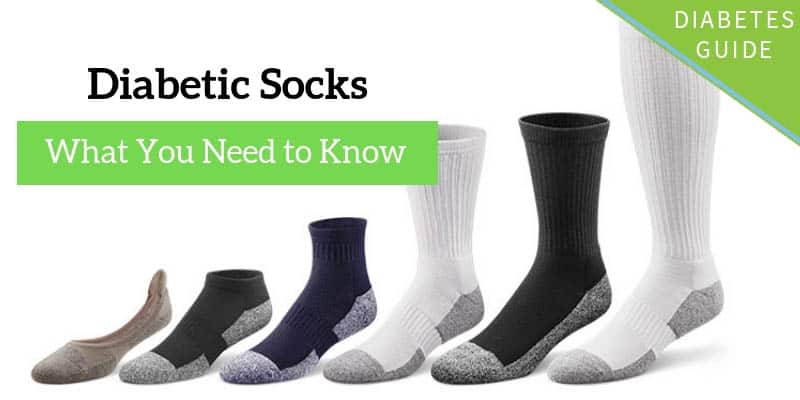The idea of having to buy special socks just because you have diabetes might feel like just another way to profit off the diabetes community.
In reality, many people with diabetes would benefit tremendously from wearing “diabetic socks,” while for others, they are simply unnecessary.
In this article, we’ll look at how diabetes affects your feet, what makes “diabetic socks” so special, who should be wearing them, and a few tips to protect and care for your feet.

How diabetes can affect your feet
In the same way that diabetes can damage the blood vessels in your eyes, your scalp, and your stomach, it can also severely damage your fingers, toes, and entire foot.
While a high blood sugar here and there is expected in day-to-day life with diabetes, persistently high blood sugar levels and high HbA1c levels will permanently damage the blood vessels and nerves throughout your entire body.
This common complication of diabetes is known as “peripheral neuropathy.”
The more damaged the blood vessels and nerves in your feet become, the more you lose the sensation and feeling in your toes and overall foot. Combining that loss of feeling with persistently high blood sugars, a simple blister or cut, and a sweaty foot that’s been tied up in socks and shoes all day…and you’ve got the perfect recipe for a potentially dangerous infection.
Generally referred to as “foot ulcers,” the Centers for Disease Control and Prevention (CDC) says these seemingly small infections are the most common event that requires a person with diabetes to get an amputation.
The longer a cut takes to heal, combined with persistently high blood sugar levels, the more likely that cut is going to become infected.
An infection that can’t be treated sufficiently with non-invasive treatments — like a “total contact cast” — is then at risk for an infection that could spread. The further it spreads throughout your toes and eventually your feet, the further threat is posed and the more likely an amputation is necessary to save your entire leg and your life.
It’s also critical to remember that once you’ve experienced a foot ulcer, the likelihood of that area becoming infected again is very high, according to the New England Journal of Medicine (NEJM).
“By reviewing 19 compatible studies on incidence rates for ulcer recurrence, we estimate that roughly 40 percent of patients have a recurrence within one year after ulcer healing, almost 60 percent within three years, and 65 percent within five years,” explains the NEJM.
The NEJM also recommends thinking of your healed foot ulcer as though it’s simply in “remission,” rather than permanently healed.
What are diabetic socks?
Simply put, socks designed specifically for people with diabetes are all about helping your feet stay dry, preventing restricting and uncomfortable rubbing, and improving blood circulation.
Keep your feet dry to prevent bacterial and fungal infections
Perhaps the most important feature that benefits people with diabetes is a diabetic sock’s ability to keep your feet dryer than ordinary socks. Diabetic socks are made with special combinations of fabric that help “wick away” moisture and keep your feet dry during exercise or a long workday.
The dampness that comes with a long day in normal socks and shoes plays a major role in your foot’s ability to heal simple cuts or blisters, putting you at risk for dangerous infections.
Common diabetic sock fabric fabrics include combinations of spandex, bamboo, elastic, lycra, cotton, nylon, viscose.
Zero seams and extra padding to prevent cuts and blisters
In addition to having zero seams to prevent uncomfortable rubbing on the tips of your toes, most diabetic socks also come with extra padding in key areas where blisters commonly occur — on your heels and the balls of each foot.
If you do a lot of walking — at work or for exercise — this extra padding could be especially helpful in preventing blisters or corns!
Improve blood flow to encourage healing and warmth
As people with diabetes, our blood circulation is inevitably impaired at least slightly.
The more developed your neuropathy is, the more critical it is to ensure those affected areas are getting adequate blood. Fresh blood is what carries oxygen to blood vessels and nerves to keep them healthy.
While an ordinary sock may cause moderate restriction, leaving visible compression lines around your ankle, diabetic socks are designed to fit well without any restriction.
Impaired blood flow can also make it harder to keep your feet warm. By wearing socks designed to improve circulation and prevent restriction, you’ll prevent that comfortable feeling of frozen toes in the winter!
White material to increase awareness of bleeding cuts
If you’ve lost feeling in your toes and feet due to neuropathy, it can be easy for even the smallest cuts or blisters to go completely unnoticed until they’ve become infected.
By wearing white socks — the color of most diabetic socks — you are far more likely to notice a bleeding cut or blister. While this may sound obvious, it could easily be the only thing that draws your attention to a problem on your foot in time to prevent dangerous complications.
Who should be wearing diabetic socks?
Simply put: anyone with diabetes could benefit from diabetic socks, but the people for whom diabetic socks could save their feet are those with neuropathy and a history of foot ulcers.
It’s important to know that “diabetic socks” are different than “compression socks.”
Compression socks are designed to increase pressure on your legs in order to increase blood pressure. This helps return blood more quickly to your heart to reduce swelling and the risk of blood clots.
Diabetic socks are designed to help save your feet from amputation by reducing your risk of cuts, blisters, infection, poor circulation, and dampness.
If your feet have been affected by your life as a person with diabetes, diabetic socks are meant for you.
You can read our guide to the best diabetic neuropathy socks for an updated review of the socks available on the market.
Tips to protect and care for your feet
In addition to wearing high-quality socks, people with diabetes — especially those who’ve been diagnosed with neuropathy — should take the following footcare tips very seriously.
Don’t go barefoot if you have neuropathy
If you have neuropathy in your feet and have lost sensation and feeling in your feet, walking around barefoot (especially outside) means you could step on something sharp, cut your foot, and not know it.
Even a thin shoe or ballet-like slipper is better than nothing at all.
Examine your feet regularly
Schedule a reminder in your phone to sit down and examine your feet at least twice a week or daily, remembering to look closely in between your toes and near your toenails, too.
You’ll be looking for any small cuts, blisters, or corns, for example, that are starting to look bright red, swollen, bloody, oozing pus, developing a green or brown color, or producing a strong odor.
If you If you’re already experienced a foot ulcer, foot inspections on a daily basis are critical to treating new cuts or ulcers quickly, preventing your risk for amputation.
If it’s difficult to reach for and examine your feet, ask a loved one to help you, or use a mirror or cell phone camera for a better look.
Change your socks halfway through the day
If you’re on your feet all day long at work or you get very sweaty during exercise, even a great pair of diabetic socks could need to be changed into a dry pair halfway through the day.
If you don’t want to invest in expensive diabetic socks, simply changing out of regular socks once or twice a day can help a great deal.
Trim your toenails and clean your feet regularly
Well, this one is simple: take care of your toenails and wash your feet daily — even if it’s just a quick rinse under the bathroom faucet.
Neglected and overgrown toenails can become “ingrown,” and create extra rubbing and irritation in your shoes. They also might make it more difficult to spot small cuts or blisters near the ends of your toes.
If you can’t comfortably reach your feet, ask a loved one, your healthcare team during your routine appointments, or visit a nail spa for assistance.
It may feel embarrassing but it’s part of saving your feet from the risk of amputation.
Wear good shoes
People with diabetes don’t have time for cheap or poorly designed shoes. If there’s any clothing item truly worth investing in…it’s your shoes. A high-quality shoe goes a long way. Whether it’s a shoe worn for exercise, shopping, or work, your feet deserve a decent place to live all day.
Improve your blood sugar levels
The absolute most important thing you can do to protect your feet from infection and amputation is by bringing your blood sugars down to a safe level.
Understanding goal ranges for your blood sugars as a person with type 1 and type 2 diabetes is the first step, but taking action to get your blood sugars and HbA1c down to that range is the challenging part.
Here are a few key articles on weight loss, exercise, nutrition, and lowering your A1c:
Call your doctor if you have any concerns
If you suspect an area on your feet isn’t healing properly or is looking a bit funky, don’t hesitate to visit your healthcare team immediately and get it checked out. Better safe than sorry!
At the end of the day, diabetic socks may not be something you can afford to wear all the time because owning enough of them can be pricey. However, you could purchase a few pairs to wear during activities that put your feet at higher risk for blisters, cuts, and sweating.
If you are looking to buy diabetic socks or compression socks, we have a buying guide and review of the best diabetic socks you can read to learn more.




Georgeanna Degenhart
Not only do yoga socks provide some extra grip, but they also wick away sweat, keep your feet warm during floor poses, and have a hygienic aspect — they can protect your skin from exposure to fungus and bacteria in public places.